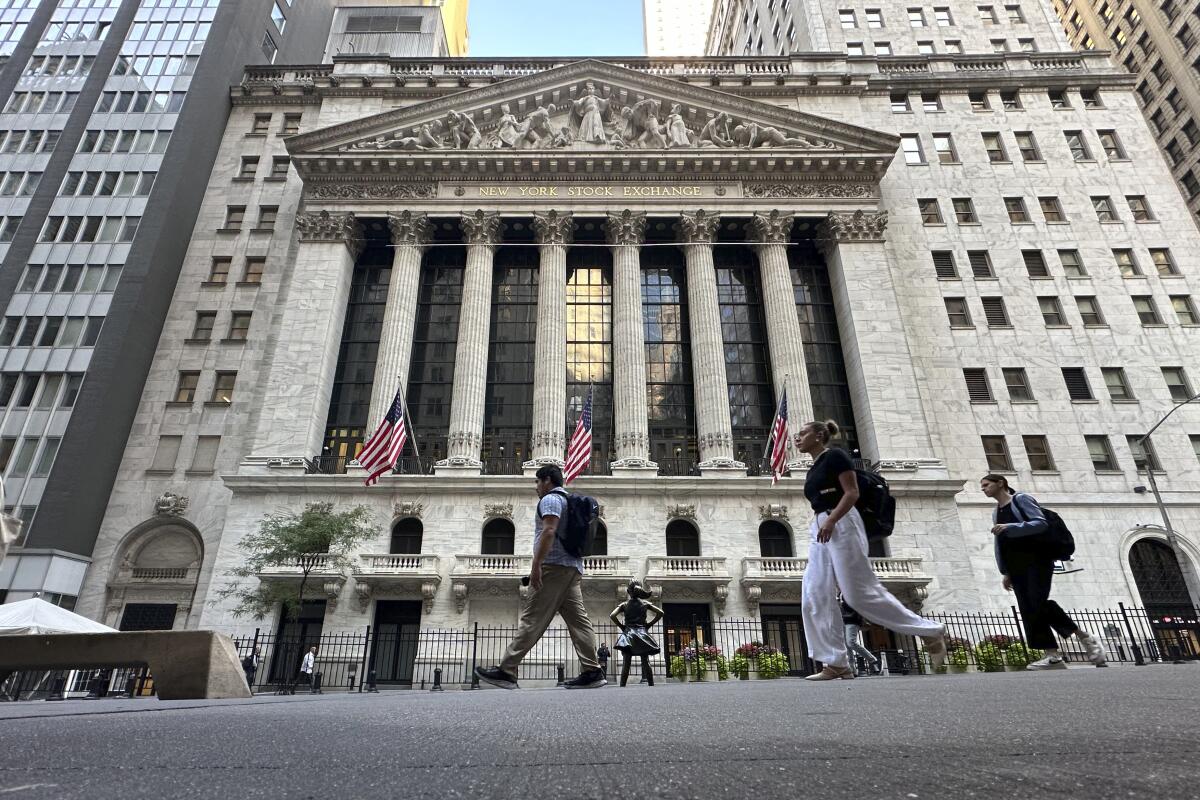Wall Street extends losses as technology and energy stocks fall

- Share via
NEW YORK — Stocks lost more ground on Wednesday as Wall Street added to its losses a day after the market’s worst skid in a month.
The Standard & Poor’s 500 fell 0.2%, following a 2.1% drop a day earlier. The Nasdaq composite dropped 0.3%. The Dow Jones industrial average managed a gain of 38 points, or 0.1%.
Technology stocks were the biggest weights on the market. Some of the bigger companies in the sector have an outsize effect on the broader market because of their large market values. Nvidia, with its $2.65-trillion market value, fell 2.1% in choppy trading. Apple fell 1.1% and Intel slid 3.7%.
Healthcare stocks also helped pull the market lower. Eli Lilly and Co. was 1.61% lower, Elevance Health dropped 2.9% and Centene slumped 8.1%.
Shares in U.S. Steel tumbled 18.1%. On Monday, Vice President Kamala Harris said during a campaign stop in Pennsylvania that U.S. Steel should remain domestically owned — concurring with the White House’s months-long opposition to the company’s planned sale to Japan’s Nippon Steel.
Job openings in the U.S. fell unexpectedly in July, a sign that hiring could cool in the coming months. The Labor Department reported that there were 7.7 million open jobs in July, down from 7.9 million in June and the fewest since January 2021. Openings have fallen steadily this year, from nearly 8.8 million in January. But overall, the report was mixed, with hiring having risen last month.
The employment market is being closely watched by investors and the Federal Reserve as a gauge of the economy’s strength. The job openings report hit Wall Street as traders anticipate that the Federal Reserve will start cutting its benchmark interest rate at its meeting later in September.
The central bank has raised rates to a two-decade high in an effort to cool inflation. The rate of inflation has been steadily easing under the weight of the higher rates, while the broader economy has remained relatively strong. The Fed’s goal was to tame inflation without stalling the economy into a recession. A weakening jobs market could raise concerns about slower economic growth ahead, but it could also mean less inflation pressure.
“Job vacancies declined, hires rose and quits were steady,” Carl Weinberg and Rubeela Farooqi, economists at High Frequency Economics, said in a note. “There is no signal here of any sudden collapse of the labor market here or any imminent recession.”
Several other reports this week will help give a clearer picture of the economy for the Fed and Wall Street.
The Institute for Supply Management will release its service sector index for August on Thursday. The service sector is the biggest component of the U.S. economy.
The U.S. will release its monthly jobs report for August on Friday. Economists polled by FactSet expect that report to show that the U.S. added 160,000 jobs, up from 114,000 in July, and that the unemployment rate edged lower to 4.2% from 4.3%. The report’s strength, or weakness, probably will influence the Fed’s plans for how it trims its benchmark interest rate.
Wall Street expects the central bank to begin trimming interest rates at its meeting later in September. Traders are forecasting that it will cut the benchmark rate by 1% by the end of 2024. Such a move would require it to cut the rate by more than the traditional quarter of a percentage point at one of its meetings in the next few months.
Dollar Tree slumped 24.3% for the biggest drop among S&P 500 stocks after the discount retailer slashed its full-year earnings forecast. Hormel Foods fell 7% after the maker of Spam trimmed its revenue forecast for the year.
Department store operator Nordstrom fell 0.9%. Members of the Nordstrom family offered to take the company private for $3.76 billion in cash, months after first expressing interest in a buyout.
In the bond market, the yield on the 10-year Treasury fell to 3.76% from 3.83% late Friday. That’s down from 4.70% in late April, a significant move for the bond market. The yield on the two-year Treasury, which more closely tracks potential action from the Fed, fell to 3.77% from 3.87%.
The 10-year Treasury and two-year Treasury are at their least inverted levels in more than two years. An inversion occurs when the shorter-duration yield is higher than the longer-duration yield. It has historically signaled a recession, though the current inversion has stood for more than two years amid a growing economy.
Troise and Veiga write for the Associated Press.
More to Read
Inside the business of entertainment
The Wide Shot brings you news, analysis and insights on everything from streaming wars to production — and what it all means for the future.
You may occasionally receive promotional content from the Los Angeles Times.










